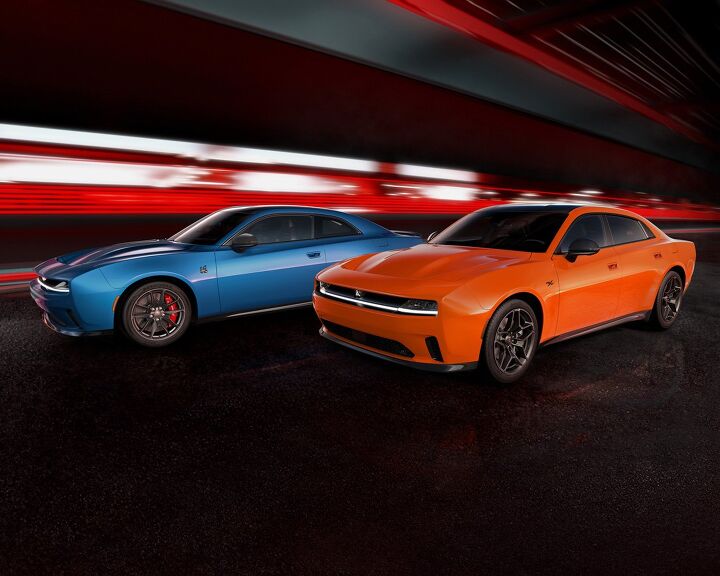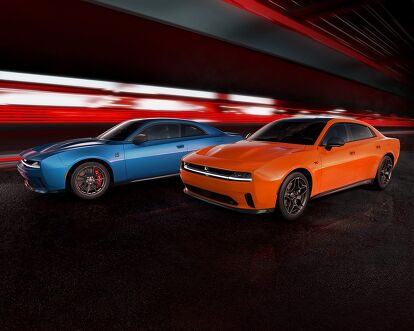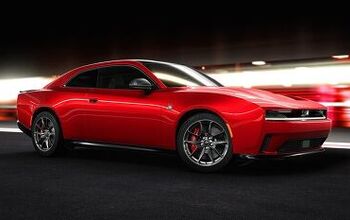2024 Dodge Charger Daytona 3-Door Ushers in the Muscle EV Era

Yes, There Will Also Be a 5-Door and Gas Versions As Well
No, that’s not a typo. You read that correctly, the new Dodge Charger is going to be a liftback, meaning it will come in three-door and five-door body styles. That’s only one of the shocking changes Dodge has in store with the reinvention of the brand’s muscle car.
We’ve Seen This Before
Before we dig into the mountain of technical details, let’s start with the exterior. The new car looks surprisingly like the concept car that debuted over a year ago because it’s the same car. Dodge claims the vehicle showcased last year was the full-production car from an exterior standpoint, minus a few very minor changes.
The 2024 Daytona certainly looks like a Charger from the outside. Regardless of if it’s the 3-door or 5-door, all of the usual styling cues are there like the rear light-back design found on most of the manufacturer’s vehicles. Up front there’s the pass-through R-Wing, a signature on all Charger Daytona models. Trims will be distinguished by fender badges, a long-standing Dodge tradition.
This is the first vehicle produced on Stellantis’ STLA platform, with many more models to come down the road. The new 2024 Dodge Charger is a big car, like really big.
At an overall length of 206.6 inches (5,248 mm), even the new three-door is over five inches longer than the current Charger four-door. It’s also an inch and a half wider at 79.8-inches (2,028 mm), and taller by over an inch at 59.0-inches (1,499 mm) high. Curb weight measures in at a jaw-dropping 5,838 pound curb weight, or heavier than most Ram 1500 full-size pickup trucks.
What’s a Muscle Car Without Power?
The 2024 Dodge Charger Daytona will launch this year with standard all-wheel drive, utilizing two familiar trim nomenclatures. The first is the R/T that will include two electric motors for a total output of 496 horsepower (hp) and 404 pound feet of torque (lb-ft). Dodge claims this will be good for a 0-60 mph time of 4.7 seconds, while the quarter mile takes 13.1-seconds. Top speed is pegged for 137 mph R/T.
The other version will be the Scat Pack that extracts 670 hp and 627 lb-ft from its two motors, which distribute power equally. The 0-60 mph drops to just 3.3 seconds, while the quarter mile breezes by in 11.5 seconds. Surprisingly, the Scat Pack as a lower top speed listed at 135 mph.
There is a bit of an asterisk to the above-mentioned power levels though. For the 2024 model year, both cars include a standard Direct Connection Stage Pack. The R/T has Stage 1 pack that adds 40 hp and the Scat Pack has Stage 2 that adds 80 hp. After this year, these upgrades will be extra cost options. If we do the math correctly, the R/T would then come standard with 456 hp while the Scat Pack should have around 590 hp.
Both cars have a power shot button on the steering wheel, which is good for a 40 hp boost for 15 seconds. Drivers can use the button as much as they want but need to wait 30 seconds between uses. All horsepower figures listed above include the 40 hp power shot.
Bring the Noise
One of the biggest deterrents of electric vehicles for some consumers, especially those that fancy muscle cars, is the lack of sound. Dodge thinks the brand has come up a solution for this dilemma, the Fratzonic exhaust.
It’s a system design to mimic the sound made from a traditional muscle car and is located where the exhaust would reside. The Fratzonic exhaust is not just a giant speaker. It’s a device that sends air through a set of pipes, just like a gas engine sends exhaust through a pipe.
Dodge assures us it will be as loud as the current hellcat cars, which are quite noisy. There is a stealth mode as well, to keep on good terms with your neighbours.
Range and Recharge
Dodge was very clear during the presentation that the Charger EV is not designed to be a long-range, super green, electric vehicle. It’s goal is to harness EV technology for maximum performance. Be that as it may, we still need to cover the vehicle’s all-electric range.
All versions of the Charger Daytona will use the same 100.5 kWh battery pack that has 93.9 useable kWh. It features a 550 kW peak discharge on all applications. This should allow the R/T to travel at least 317 miles on a charge while the Scat Pack is estimated to be around 260 miles.
Once depleted, the car can recharge at up to 183 kW, which Dodge claims will take the battery 27 minutes to go from 20% to 80% full.
A Big Car Needs Big Hardware
The Charger Daytona comes standard with a limited slip rear differential and 18-inch wheels on the R/T. Twenty-inch wheels are optional on R/T, and standard on Scat Pack.
To help control this behemoth, the Scat Pack can come with a track pack. It includes monstrous 305/35ZR20 front tires with 16-inch brake rotors housed inside. The rear tires are even larger, at 325/35ZR20, and the suspension gets upgraded to a dual-valve semi-adaptive set-up.
All the Drive Modes
What would be an electric vehicle, especially a muscle car one, without drive modes? The Charger Daytona will include the usual modes like auto, eco, sport, and wet/snow. The Scat Pack can also include track, drag, drift, donut, line lock, launch control, and race prep.
Some of these drive modes have our attention, like the donut mode that:
“Enables the vehicle to spin only the rear wheels and to rotate around either of the front wheels without intervention from the traction control system.”
The drift mode is even more complex, as Dodge states:
“The driver can select three levels of slip angle, and torque is rear-axle biased, using the front axle to help maintain slip angle. Front dampers become full soft and rear dampers go full stiff to enable an oversteer condition, and the traction control system allows for different wheel speed differentials without setting fault codes.”
These two features sound like a lot of fun and many owners will use donut and drift mode responsibly on a closed course. But for a few others, well, we'll wait for the inevitable online videos to surface of Charger Daytona’s impersonating Ford Mustangs, smacking the nearest solid obstruction while leaving cars and coffee events.
Modern Interior for a Modern Car
Like the exterior and drivetrain, the inside of the Charger Daytona does its best to blend traditional styling cues with modern technology. The cabin is driver centric, with a thin dash interface. The steering wheel has a squared off shape and features regen paddles. Between the two front seats resides a pistol grip gear selector.
To exit the Charger Daytona, there is a button on the door in lieu of a traditional handle. Two sets of seats are available, with the upgraded ones having a thin, racecar design to them.
Passengers in those front seats receive 39.1-inches (992 mm) of headroom and 42.6-inches (1,081 mm) of legroom. For three-door models, the rear seat still has 36.9-inches (938 mm) of headroom and 37.2-inches (945 mm) of legroom, which is not bad for a coupe-like shape. Behind the rear seats the lift gate can hold an impressive 37.4 cubic feet (1,059 L) of cargo.
Displays Upon Displays
Standard on the R/T is a 10.25-inch driver information cluster. A larger 16-inch display is standard on the Scat Pack and optional on the R/T. It can be customized with different driver information set-ups. All vehicles come with a 12.3-inch infotainment screen running Uconnect 5 software. As well, there are available performance pages, EV pages, drive mode pages, and race mode pages.
Optional on all trims is a giant 8-liter augmented head-up display. When driving in track mode, it projects a large g-force meter. Also optional is a driver recorder that will sync up sound, video, and vehicle information during driving sessions. Content can then be uploaded to the cloud or shared via a USB stick.
Other notable technology available on the Charger Daytona includes wireless phone integration, 64 interior ambient light choices, a steering wheel button to quickly switch to preferred vehicle settings, as well as an 18-speaker, 914-watt Alpine system with subwoofer.
There Will Be More Power…and Gas
The Daytona is just the beginning of the new Charger. Next year the aforementioned five-door models will be launched along with the higher performance all-electric Banshee. Not much is known at this time about the Banshee other than it will be 800v, have a two-speed gearbox, and be quicker than any Dodge Charger that came before it. Yes, even including the Jailbreak Hellcats.
Burying potentially the biggest news right at the end of our article, 2025 will also see the addition of gas-powered Chargers. Call the Dodge Charger SIX-PACK, it will be available as the SIX-PACK S.O or the SIX-PACK H.O.
Both cars will come with the new hurricane turbocharged inline-six engine (get it, SIX-PACK?). In the S.O., or standard output, it will make 420 hp. In the H.O. (high output), it will generate 550 hp. Both engine tunes will be paired to an eight-speed automatic transmission and have standard all-wheel drive. But do not fret burnout-loving readers; there will be an option to put the car into rear-wheel drive mode when feeling so inclined.
Astute readers may have noticed gas powered Chargers drop the Daytona moniker from the name. This is because only the battery-electric Chargers have the R-Wing nose cone. So, like the famous 1969 Charger Daytona, no nose cone = no Daytona designation.
Like the all-electric vehicle, the gas-powered Charger will come as a 3-door or a 5-door.
Production of the new Charger is set to begin at the Windsor, Ontario, Canada assembly plant soon.
Become an AutoGuide insider. Get the latest from the automotive world first by subscribing to our newsletter here.

A 20+ year industry veteran, Mike rejoins the AutoGuide team as the Managing Editor. He started his career at a young age working at dealerships, car rentals, and used car advertisers. He then found his true passion, automotive writing. After contributing to multiple websites for several years, he spent the next six years working at the head office of an automotive OEM, before returning back to the field he loves. He is a member of the Automobile Journalists Association of Canada (AJAC), and Midwest Automotive Media Association (MAMA). He's the recipient of a feature writing of the year award and multiple video of the year awards.
More by Mike Schlee




















































































Comments
Join the conversation